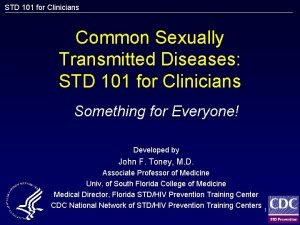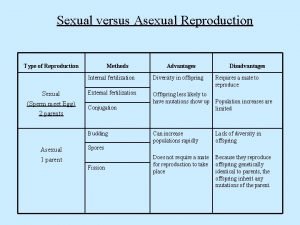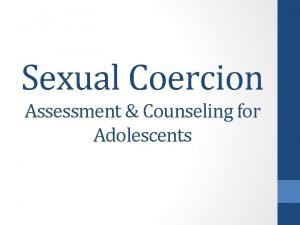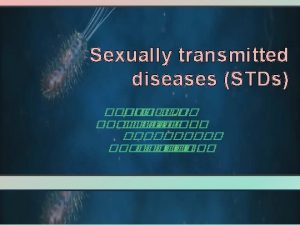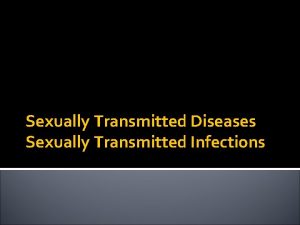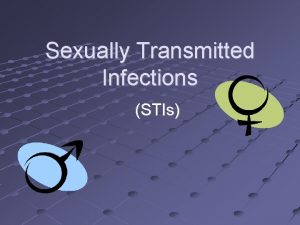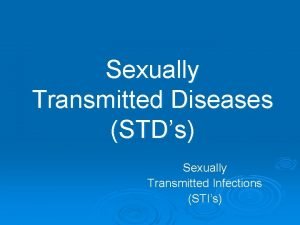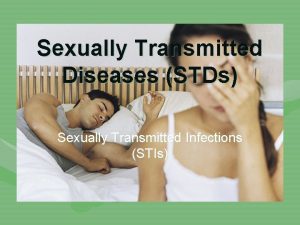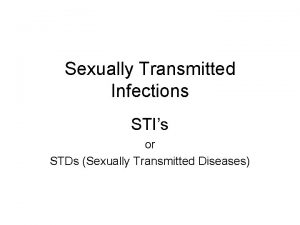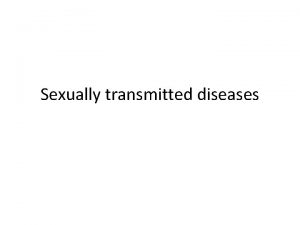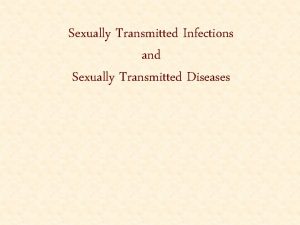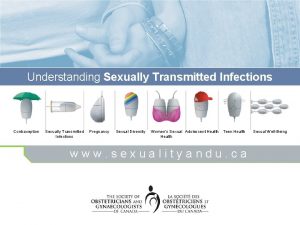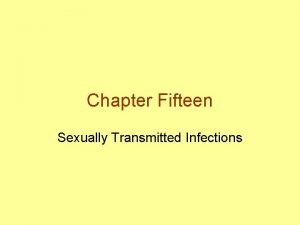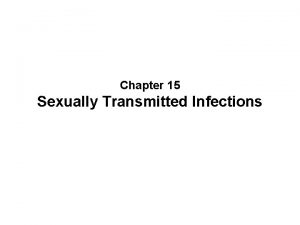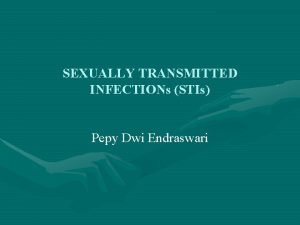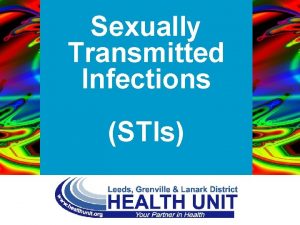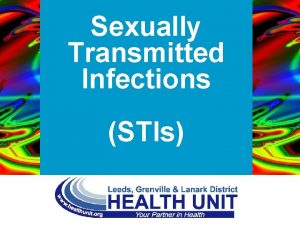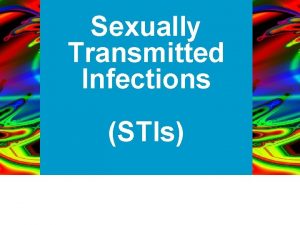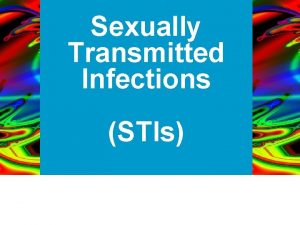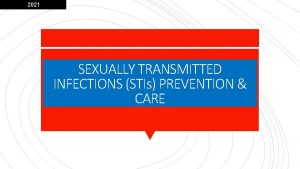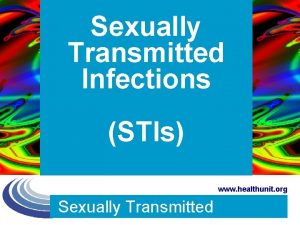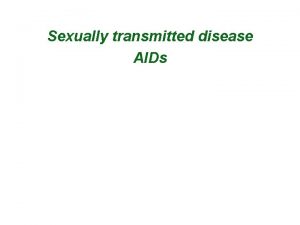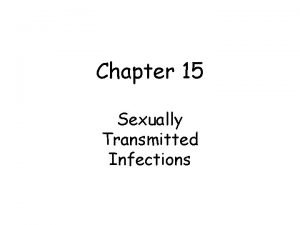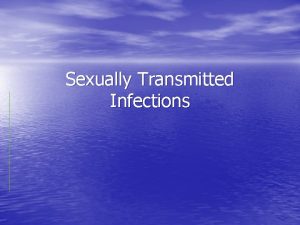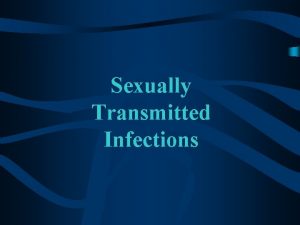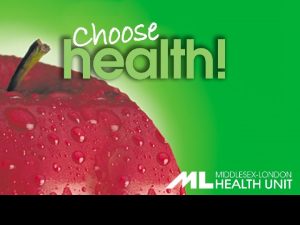Unit 13 Sexually Transmitted Infections STIs HIVAIDS Natural







































- Slides: 39

Unit 13: Sexually Transmitted Infections (STI’s)

HIV/AIDS

Natural history of HIV/AIDS Probably originated in Africa AIDS (acquired immune deficiency syndrome) is caused by the HIV virus (Human immunodeficiency virus) The HIV virus infects T-cells (white blood cells) makes copies of itself then destroy these T-cells Body make antibodies for virus (HIV test checks for their presence) Our body can’t get rid of HIV fully because HIV weakens the immune system to begin with HIV replicates too fast for our immune system to fight it HIV can mutate (therefore changing its antigen), to avoid elimination A ‘positive HIV’ test means you have HIV antibodies in your blood Sometimes takes weeks to months to show antibodies Concern = ____________________

Natural history of HIV/AIDS • Early symptoms include fever, fatigue, swollen lymph glands (often mistaken for flu/cold) • Most people who get HIV will eventually develop AIDS • However, AIDS has a long latent period (≈10 years) • People may infect others without even knowing because they don’t show the signs/symptoms of infection • Destroyed T cells leave a person very susceptible to opportunistic infections

Transmission • NOT highly contagious • Transmission requires intimate contact between body fluids (blood, semen, breast milk) often through: – Unprotected sex – Unsterile needles – Mother to fetus or infant – Blood transfusion – Risk from highest to lowest: Anal intercourse > vaginal intercourse >>>>oral sex >>>>> wet kissing , urine, sweat, tears

Transmission • More likely to occur during anal intercourse than vaginal intercourse because: – Rectum lining is thin – Rich blood supply in the rectum – Rectum has a lot of white blood cells that have the HIV receptor – The skin is often damaged – The vagina has better natural lubrication

HIV Stages after Transmission • First Stage – primary HIV disease – Early cold/flu like symptoms, may have a rash – Not early enough to show a + HIV blood test • Second Stage – chronic asymptomatic disease of immune cells without disease symptoms – cont. swollen glands – vulnerability to opportunistic infections – • Third Stage – chronic symptomatic disease – Thrush – yeast infection of the mouth – Body weakness and discomfort, sustained fever, night sweats, weight loss, and frequent diarrhea

HIV Infection http: //www. hivcenternyc. org/newsletter/preview/300 px. Symptoms_of_acute_HIV_infection. png

High Risk Groups

Canada • Female incidence is increasing • It used to be that most cases (80%) were in men who have sex with men (MSM) (1989), now more heterosexuals are being diagnosed • The decline in mortality is attributed to: – Public education to use condoms – Antiretroviral drugs (ART) reduce infectiousness and transmission

HIV Prevalence

New HIV Cases

HIV/AIDS Epidemiology Kilmarx 2009

Epidemiology of HIV/AIDS • Higher risk groups include: – Men who have sex with men – Sex trade workers – Injection drug users – Aboriginals

Treatment/ prevention No effective vaccine exists Some recent progress (published in New England Journal of Medicine): canarypox vector vaccine (ALVAC-HIV [v. CP 1521]) + boasters administered to heterosexual healthy individuals in Thailand monitored for 3 yrs at 6 mn intervals “community-based, randomized, multicenter, double-blind, placebo-controlled efficacy trial” New infections= Vaccine group= 51 of the 8, 197 Placebo group= 74 of the 8, 198 statistically significant difference Still very far from eradication!!

Treatment/ prevention Prevention is the key: Practice safer sex! Wear a condom, avoid multiple sex partners, know your partner’s sexual history/last STI test • • Don’t combine drug use and sex Avoid injection drugs Avoid “sketchy” tattoos and body piercing HIV testing (prevents transmission)

HERPES SIMPLEX

Herpes Simplex Overview Caused by the herpes virus Two types HSV 1 typically affects the mouth/lips HSV 2 typically affect the genitals Appears as recurrent temporary lesions (ex. Cold sores) on the lips, mouth genitals etc) 1/5 of sexually active people have had HSV infection in Canada

Herpes “fever blisters” If you think this slide is bad. . Be thankful I didn’t post any genital herpes pictures! Wear a Condom!!!!

Herpes simplex overview There is no cure Antiviral drugs may shorten episodes Have it for life HSV 2 is easier to protect against Don’t touch genitals as much Can use a condom

Secondary Prevention • List of things one can try to decrease episodes – Stress Management – Vit B – Exercise – Decrease production of cortisol – Amino Acid L-Lysine - seems to help with type 1 (Smirnova IP et al. 1998) – Mutations can occur between Herpes Simples 1 and 2 - oral sex?

HEPATITIS

Hepatitis Overview • Hepatitis = inflammation of the liver • There are six variations of the virus that causes it (A, B, C, D, E and G) • Initial symptoms are similar to the flu, may progress to nausea, vomiting, dark urine, abdominal pain, jaundice (yellow skin) • Chronic hepatitis can cause cirrhosis of the liver, liver cancer and death

Hepatitis

Hepatitis Overview • Hep A and Hep E transmitted through fecaloral contact, typically through contaminated water • Hep B, and C transmitted through the exchange of bodily fluids – Sexual intercourse (B, not C), contaminated needles main route of transmission • Hep D/G usually occur as co-infections, not on their own

Prevention/Treatment Prevention • Vaccines are effective against Hep. A and B • Hep. B vaccine also confers protection against Hep. D/G • Safe sex (B, D, G) • Clean drinking water (A, E) Treatment • There is no cure • Antiviral drugs may help • Liver transplants indicated in advanced cases

Genital Warts- HPV • Genital warts are caused by the human papilloma virus (HPV) and often show no symptoms • If left untreated, genital warts can lead to cervical cancer and perhaps cancers of other genitalia an association of 90% • Warts can be surgically removed, burned/frozen off

HPV • There are more than 100 known strains (Mayo Clinic, 2010) • Symptoms show up months or years after exposure – Color range from pink in moist areas, greyishwhite warts in dry area – Can be painless, or cause itching and inflammation – Appear on penis, vulva, anal area, or urethra – Risk increase of HPV leading to cervical cancer if the woman is also infected with herpes (J. S. Smith, 2002, Kelly, 2006)

HPV

OTHER STI’S

Chlamydia • Most commonly reported STI in Canada • ≈63, 000 cases (2004) highest number of cases since 1990 (first reported) • Chronic long-term consequences: infertility, chronic pelvic pain and ectopic (out of place)pregnancy (life-threatening)

Chlamydia • Incubation Period 7 -21 d from vaginal or anal intercourse • Symptoms – Genital discharge – Burning during urination( not specific to men) – Lower abdominal pain or during intercourse (women) – ¾ of cases in women have no symptoms (Kelly, 2006)

Chlamydia Treatment • Treatment – Weeklong regimen of azithromycin, doxycycline, or erythromycin • Who is the most at risk? _______________ (Kelly, 2006)

Gonorrhea • Second most commonly reported STI in Canada • Rates have doubled from 14. 9 per 100, 000 (1997) to 28. 9 per 100, 000 (2004) • > 60% of reported cases = males. • Incubation period – 2 -6 days up to 30 d • Treatment – oral doses of ceftriaxone, ciprofloxacin or ofloxacin

Symptoms of Gonorrhea/Chlamydia Often occur together! – Increased vaginal discharge – Irregular bleeding – Abdominal pain – Pain while urinating – Thick greenish-yellow penile discharge – Pain in testicles

Syphilis • Rates increasing in Canadian males and females. – 0. 4 per 100, 000 (Males, 1997) – 6. 3 per 100, 000 (Males, 2004) • 15 times higher! • 82% of all reported cases = men 30 -59 • 1 st symptom typically = sore • 2 nd symptom = body rash, flu-like symptoms • Untreated can damage heart, brain, eyes, nervous system, bones and joints • Treatment: single injection of penicillin, tetracycline, erythromycin, or doxycycline

Chlamydia, Gonorrhoea and Syphilis • Bacterial infections, all on the rise • Treated with antibiotics • Symptoms sometimes hard to identify

• • Pubic Lice Aka “crabs” Live by feeding on blood in the pubic area Sexual transmission – eggs hatch 5 -10 days Non-sexual contact – Towels, bed sheets, mattresses • Treated with creams, shampoos

TAKE HOME MESSAGE WEAR A CONDOM!!!!!!
 Chapter 25 sexually transmitted infections and hiv/aids
Chapter 25 sexually transmitted infections and hiv/aids Chapter 24 lesson 1 sexually transmitted diseases
Chapter 24 lesson 1 sexually transmitted diseases Chapter 24 sexually transmitted diseases and hiv/aids
Chapter 24 sexually transmitted diseases and hiv/aids Sti std
Sti std Nursing management of reproductive tract infection
Nursing management of reproductive tract infection Std
Std Opportunistic infections
Opportunistic infections Methotrexate and yeast infections
Methotrexate and yeast infections Opportunistic infections
Opportunistic infections Johnson and johnson botnet infections
Johnson and johnson botnet infections Storch infections
Storch infections Storch infections
Storch infections Bone and joint infections
Bone and joint infections Infections opportunistes digestives
Infections opportunistes digestives Eye infections
Eye infections Postpartum infections
Postpartum infections Retroviruses and opportunistic infections
Retroviruses and opportunistic infections Genital infections
Genital infections Amber blumling
Amber blumling Opsonization
Opsonization Classification of acute gingival infections
Classification of acute gingival infections How do whales reproduce sexually
How do whales reproduce sexually Phylum and class
Phylum and class Invertebrates characteristics
Invertebrates characteristics Run away selection
Run away selection Rules of consent
Rules of consent Reproduction of protist
Reproduction of protist Was it sexual abuse quiz
Was it sexual abuse quiz Concentricycloidea
Concentricycloidea Animal like protists
Animal like protists Male orgasm anatomy
Male orgasm anatomy Do worms reproduce sexually or asexually
Do worms reproduce sexually or asexually Sexual harassment training quiz
Sexual harassment training quiz Atis sexually or asexually
Atis sexually or asexually Cnidaria class
Cnidaria class Radial symmetry examples
Radial symmetry examples Frustrated freight
Frustrated freight Pinacoderm
Pinacoderm How do birds mate
How do birds mate Dimorphism meaning
Dimorphism meaning





